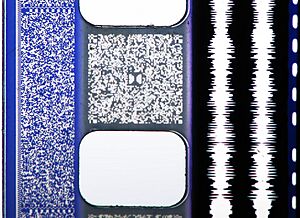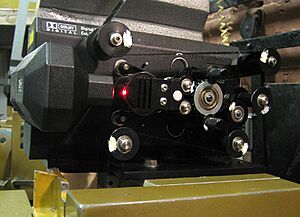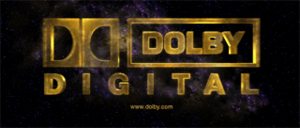Dolby Digital facts for kids
 |
|
| Abbreviation | DD |
|---|---|
| Formation | 1986 |
| Type | Audio compression format, lossy compression |
| Location |
|
|
Area served
|
Worldwide |
Dolby Digital is a group of technologies created by Dolby Laboratories that make audio files smaller. It was first called Dolby AC-3 and later Dolby Stereo Digital until 1995. This technology uses a special way to compress sound, which means it makes the file size smaller. Most Dolby Digital versions use lossy compression, which removes some sound information to save space.
Dolby Digital was first used to bring digital sound to movies shown in cinemas from 35 mm film. Since then, it has been used for TV, radio, online videos, DVDs, Blu-ray discs, and even video games.
The main idea behind Dolby Digital is a special math tool called the modified discrete cosine transform (MDCT). This tool helps to compress audio. It was developed in 1987 at the University of Surrey. Dolby Laboratories then used this tool, along with ideas about how humans hear sound, to create the AC-3 audio format for movies. The Dolby Digital standard was released in 1991. It was one of the first audio compression standards of its kind. Later, other similar formats like MP3 and AAC came out.
Contents
How Dolby Digital Works in Cinemas
The movie Batman Returns was the first film to use Dolby SR-D technology in 1992. In cinemas, Dolby Digital soundtracks are recorded right onto the 35 mm film. The data is placed between the tiny holes on the film's edge. This data is read by a special scanner in the movie projector. The scanner turns the data into a digital signal, which is then decoded into 5.1 channels of sound.

Movie films with Dolby Digital also have older, analogue soundtracks. These are a backup in case the digital system has problems. This also makes sure the film can be played on older projectors. Today, most movie films include Dolby Digital data. They might also have data for other sound systems like SDDS and DTS.
To add Dolby Digital to older movie projectors, a special "penthouse" soundhead can be added above the projector. For new projectors, both analogue and digital soundheads are built in. Dolby Digital is still a very common sound format for movies. Newer technologies like Dolby Surround 7.1 and Dolby Atmos have also been introduced.
Different Kinds of Dolby Digital
Dolby Digital has several versions and related technologies. These include Dolby Digital EX, Dolby Digital Live, and Dolby Digital Plus.
What is Dolby Digital?
| Filename extension |
.ac3
|
|---|---|
| Internet media type |
audio/ac3
|
| Uniform Type Identifier (UTI) | public.ac3-audio |
This is the most common version. It can have up to six separate sound channels. The most popular setup is 5.1 channels. This means five channels for regular speakers (right, center, left, right surround, left surround) and one channel for a subwoofer. The subwoofer handles low-frequency sounds like explosions. Dolby Digital also supports simple mono (one channel) and stereo (two channels) sound.
This format is also known by other names:
- DD (short for Dolby Digital, often with the number of channels, like DD 5.1)
- AC-3 (Audio Codec 3)
- ATSC A/52 (the name of the standard)
In 1991, Star Trek VI: The Undiscovered Country was shown in Dolby Digital in a few US theaters. Batman Returns was the first movie widely released with Dolby Digital in 1992. In 1995, the LaserDisc version of Clear and Present Danger was the first to feature a Dolby Digital mix for home theater systems.
What is Dolby Digital EX?
Dolby Digital EX adds more sound channels to the standard 5.1 setup. It uses a special "matrix" technology to create 6.1 or 7.1 channels of sound. This means it can add a center back surround channel to make sounds feel like they are coming from more specific places around you.
The theater version of Dolby Digital Surround EX was first used in 1999 for Star Wars: Episode I – The Phantom Menace. Many DVDs also have a Dolby Digital Surround EX audio option.
What is Dolby Digital Live?
Dolby Digital Live (DDL) is a technology that encodes audio in real-time. This is useful for video games on a PC or game console. It takes any audio and turns it into 5.1-channel Dolby Digital sound. This sound can then be sent through a single cable called S/PDIF. This allows digital multichannel sound to be used with regular sound cards.
DDL is found in sound cards from different companies. For example, some Realtek and C-Media audio chips support it. Creative Labs also added DDL support to some of their X-Fi sound cards.
What is Dolby Digital Plus?
| Internet media type |
audio/eac3
|
|---|---|
| Uniform Type Identifier (UTI) | public.enhanced-ac3-audio |
E-AC-3, or Dolby Digital Plus, is an improved version of the AC-3 codec. It can handle higher bitrates, meaning more data per second. This allows for better sound quality or more audio channels, up to 15.1 channels in the future. It also uses better ways to compress sound.
Older equipment might not be able to play E-AC-3 directly. However, E-AC-3 decoders can usually convert the sound to regular AC-3 for older devices. The fourth generation Apple TV supports E-AC-3. It was also used in HD DVDs and is an option for Blu-ray Discs.
What is Dolby TrueHD?
Dolby TrueHD is an advanced audio format that uses lossless compression. This means it compresses the audio without losing any sound information. It supports very high sound quality, with 24-bit depth and sample rates up to 192 kHz. It can also support up to 16 audio channels. Dolby TrueHD was required for HD DVD players and is an option for Blu-ray Disc players.
How Many Channels Can Dolby Digital Have?
While Dolby Digital is often linked to 5.1 channels, it can actually support many different channel setups:
- Dolby Digital 1/0: Mono (sound from one center speaker only).
- Dolby Digital 2/0: 2-channel stereo (left and right speakers).
- Dolby Digital 3/0: 3-channel stereo (left, center, right speakers).
- Dolby Digital 2/1: 2-channel stereo with a single surround speaker.
- Dolby Digital 3/1: 3-channel stereo with a single surround speaker.
- Dolby Digital 2/2: 4-channel sound (left, right, left surround, right surround).
- Dolby Digital 3/2: 5-channel surround (left, center, right, left surround, right surround).
These setups can also include the extra low-frequency effects (LFE) channel, which is the ".1" in 5.1. Many Dolby Digital systems can also adjust the sound if you don't have all the speakers. For example, if you don't have surround speakers, the sound can be played through the front speakers.
Where is Dolby Digital Used?
Dolby Digital audio is used on DVD-Videos and other digital media like home cinema systems. It's also used in digital TV. The AC-3 standard allows a maximum data rate of 640 kbit/s. For 35 mm film, the rate is 320 kbit/s. DVD-Video discs are usually limited to 448 kbit/s.
Blu-ray Disc players, the PlayStation 3, and the Xbox game console can output a full 640 kbit/s AC-3 signal. Some PlayStation 2 games also use AC-3 audio, especially during video scenes.
Dolby also helped create AAC, which is another audio compression format. Dolby Digital Plus and TrueHD are supported on HD-DVD and Blu-ray Disc.
Dolby Technologies in Media Formats
Here's a quick look at how Dolby technologies are used in different types of media:
| HD DVD | Blu-ray Disc | DVD-Video | DVD-Audio | LaserDisc | |||||||||||
|---|---|---|---|---|---|---|---|---|---|---|---|---|---|---|---|
| Codec | Player support | Channels (max) | Max bit rate | Player support | Channels (max) | Max bit rate | Player support | Channels (max) | Max bit rate | Player support | Channels (max) | Max bit rate | Player support | Channels (max) | Max bit rate |
| Dolby Digital | Mandatory | 5.1 | 504 kbit/s | Mandatory | 5.1 | 640 kbit/s | Mandatory | 5.1 | 448 kbit/s | Optional in video zone for playback compatibility on DVD-Video players | 5.1 | 448 kbit/s | Optional | 5.1 | 384 kbit/s |
| Dolby Digital Plus | 7.1 | 3 Mbit/s | Optional | 7.1 | 1.7 Mbit/s |
|
|||||||||
| Dolby TrueHD | 7.1 | 18 Mbit/s | 7.1 | 18 Mbit/s | |||||||||||
AC3RF
In the world of LaserDisc players, "AC3RF" is a term often seen on connectors. This means the player supports Dolby Digital sound. Some older audio devices from the 1990s and early 2000s also had this label. LaserDisc movies with Dolby Digital sound often had the THX logo on their covers.
Licensing and Open Source
For a long time, companies had to pay a fee to use AC-3 technology because it was covered by patents. These patents expired in March 2017, meaning AC-3 is now free for anyone to use.
Some open-source software, like FFmpeg and the VLC media player, already included code to handle AC-3 even before the patents expired.
See Also
 In Spanish: Dolby Digital (AC-3) para niños
In Spanish: Dolby Digital (AC-3) para niños
- Dolby Laboratories – the company that created Dolby Digital
- Dolby Stereo – an older analogue surround sound format
- Dolby Pro Logic – a system for decoding surround sound from stereo tracks
- DTS (sound system) – another company that makes sound systems
- Home cinema – setting up a movie theater experience at home
- Loudspeaker – a device that turns electrical signals into sound
- Surround sound – a way to make sound come from all around you





